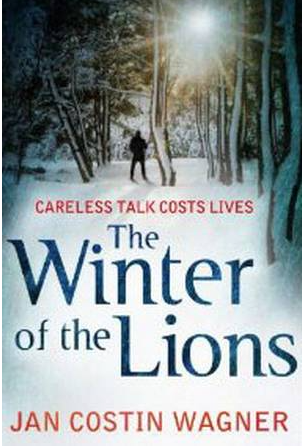
Jan Costin Wagner may very well be THE discovery of this year’s German Literature Month for me. I started The Winter of the Lions, book three in the series, in October and since then I’ve already read Silence, book two, have started book one, Ice Moon, and ordered the remaining two novels. Book five just came out in German. Now you certainly wonder why I’ve started the series backwards. There’s a reason, although, now that I’m reading book one I know, I shouldn’t have worried. I knew that Detective Kimmo Joentaa loses his wife in book one. I thought that a large part of the book would focus on her illness, but she dies in the first two pages and the book is about grief and loss, not about illness. The death of Joentaa’s wife, which is a recurring theme in every book, underlines that each novel is, at its core, a meditation on death.
It’s interesting that reading the series backwards makes me much more aware of how much Joentaa is changing. And it’s precisely this change which makes the series such a great read. Joentaa is not only likable but complex and sensitive, a truly appealing character. I’m also pleasantly surprised about how different each book is, although there are many similarities. In the first, Ice Moon, most chapters are written from Joentaa’s point of view, a few from the murderer’s perspective. In book two, Silence, we have a whole chorus of voices. Joentaa’s is only one of many. In The Winter of the Lions, Wagner uses a similar approach as in Ice Moon. Most chapters are written from Joentaa’s point of view, only a few from the point of view of the murderer.
What makes this series so outstanding is the choice of themes. While the detective has to find the murderer the books are much more an exploration of the reasons why someone was killed than simple “whodunits”. Only in finding the reason for a murder, does Joentaa find the killer.
The careful uncovering of the reason behind a series of murders is even more important in The Winter of the Lions than in the first two books. While book one focuses on the meaning of death, book two is a study of guilt, and book three looks into the way we treat other people’s tragedies.
The Winter of the Lion starts on Christmas Eve. Joentaa has been a widower for two years and has come to terms with his loneliness. He even looks forward to spend Christmas on his own. While he’s still at the police station, a young woman wants to report a rape. She’s a prostitute and pretends one of her customer’s has raped her. When Joentaa begins to ask questions, she withdraws. She doesn’t want to go into details.
Surprisingly the same woman, rings Joentaa’s door bell a little while later, when he’s back home. She spends the night with him and they begin a very unusual relationship.
The strange woman isn’t the only one to disturb Joentaa’s quiet Christmas. One of his colleague’s, the police pathologist, is found stabbed in a snowy wood. A little while later a puppeteer is killed and a famous talk show host is attacked.
All of the victims of the perpetrator in The Winter of the Lions took part in a talk show, in which victims of accidents, fires, and murder were the topic of the discussion.
One of the many questions the book asks is: When does one person’s tragedy become another person’s entertainment? I would love to write in more details about the topics in the book but I would spoil it.
What made me love Wagner’s books even more was his writing style. This is crime at the literary end of the spectrum. The sentences are short, spare, and very precise.
As if all of this wasn’t enough there’s a haunting atmosphere in every book and the Finnish setting is another bonus, especially since each book takes place during another season. I loved to read about the long nights in winter and the endless days in summer.
Should you wonder why a German author chose to set his books in Finland —Wagner is married to a Finnish woman and spends half of the year in Finland.
This is one of the best crime series I know. Haunting, atmospherical, with philosophical depth and impeccable writing.
